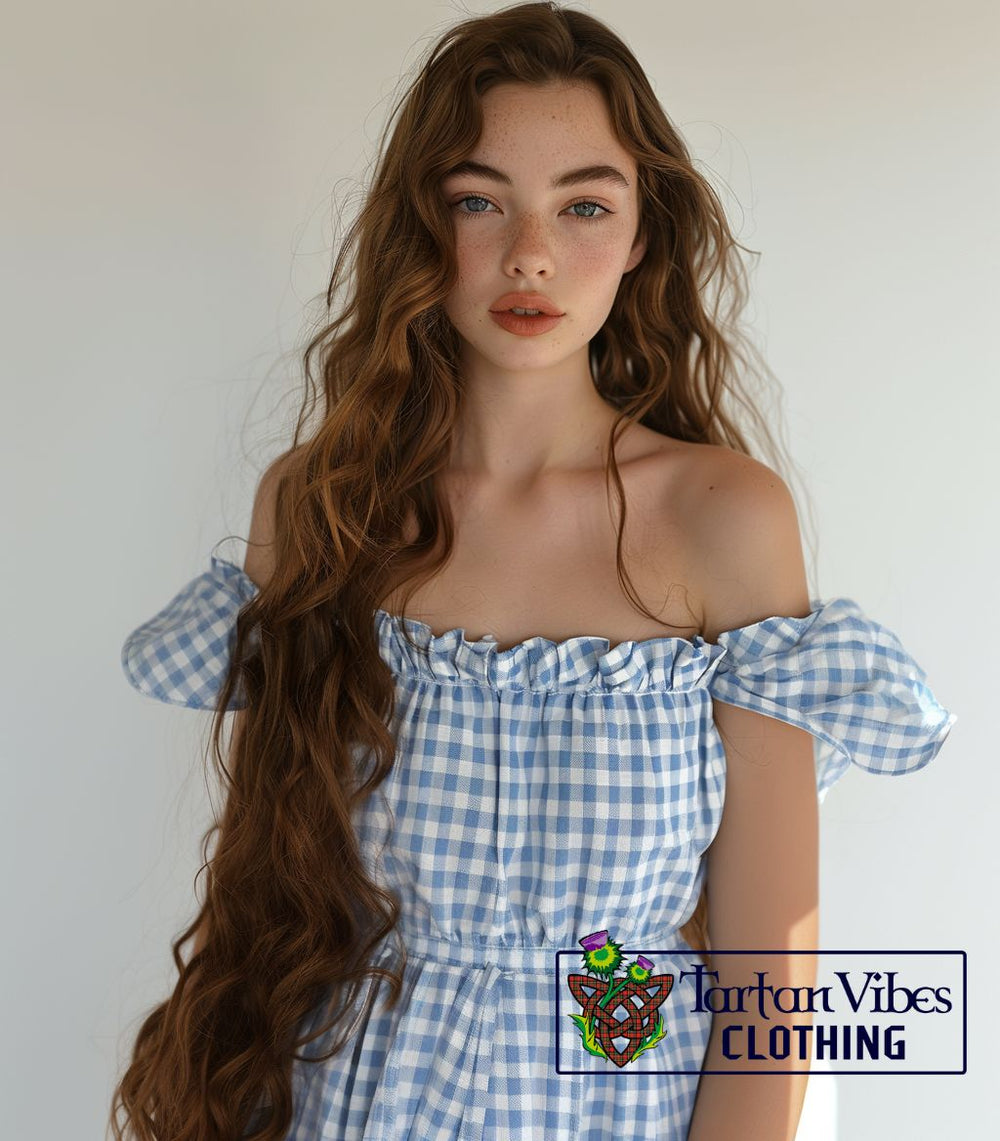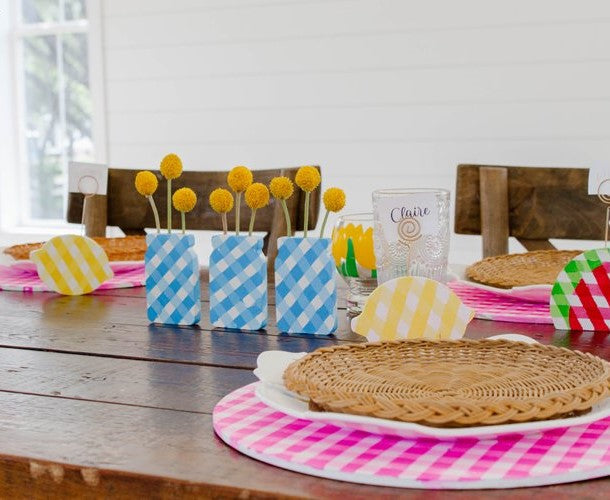Table of Content
What Is Gingham? Gingham is a classic fabric that has woven its way into fashion and home décor for centuries. Characterized by its checked pattern, this versatile textile has a rich history and numerous applications. In this article, we’ll delve into everything you need to know about Gingham, including its origins, uses, and how to incorporate it into your wardrobe and home.
I. What Is Gingham Fabric?

Gingham, also known as Vichy check, is a medium-weight, balanced, plain-woven fabric with vibrant duotone patterns, typically in combinations like red and white or blue and white. Made from dyed cotton or cotton-blend yarns, Gingham showcases a checked design that can vary in size. Its construction utilizes carded medium or fine yarns woven in a plain weave, resulting in a versatile and reversible fabric that appears the same on both sides. Due to its affordability and ease of production, Gingham is a favored choice for various applications, including button-down shirts, dresses, and tablecloths, making it a staple in both fashion and home décor.
💥Summary of Gingham Characteristics
Characteristic |
Description |
Material |
Created from cotton or a fabric that includes cotton. It is airy and pleasant to wear, perfect for hot conditions. |
Pattern |
A checked design consists of horizontal and vertical lines, typically in matching colors, intersecting on a white backdrop. |
Color |
Traditional gingham consists of a two-color design, usually featuring red and white or blue and white. However, contemporary versions may incorporate several colors. |
Durability |
Recognized for its strength and low maintenance. It withstands frequent washing and retains its color and form effectively. |
Texture |
Typically smooth and uniform, featuring a well-balanced plain-weave design. |
Uses |
Often utilized for garments such as dresses, shirts, and table linens. It's also favored in interior design. |
II. The Origins of Gingham
It is believed that the fabric called Gingham may have originated in Guingamp, a town located in Brittany, France, and possibly named after it. One hypothesis suggests that the term “gingham” derives from the Malay word “genggang,” meaning “striped,” which transitioned to Dutch as “gingang” and eventually became “gingham” in English. When it was first brought to Europe during the 17th century, Gingham was characterized by stripes, but it is currently recognized for its checkered design.

From the mid-18th century, when production began in Manchester, England, it started to be woven into checked or tartan patterns , frequently blue and white. Over time, checked Gingham became increasingly prevalent, although striped Gingham remained available through the late Victorian era. Gingham was imported to France from Malaysia and began being produced in Vichy, France, during Napoleon Bonaparte's rule. In Spain, this design is referred to as estampado vichy or cuadro vichy. In the United States, the widespread appeal of men's blue and white gingham shirts in the 2010s resulted in significant media attention on the trend.
III. What Makes Gingham Unique?
Gingham is famous for its unique check pattern, featuring uniformly sized squares in contrasting colors that create an attractive look. This fabric utilizes a basic plain weave, where the threads run over and under each other, which adds to its strength and durability. Although many people mistake it for plaid patterns or tartan, Gingham distinguishes itself with its uncomplicated, repeating checks, while plaid displays more intricate patterns with various stripe widths and hues.

A key feature of Gingham is its reversibility, enabling it to be worn on both sides since the checkered pattern is visible from either direction. Usually crafted from lightweight cotton or cotton blends, Gingham is airy and comfortable, making it ideal for summer clothing. The gentle texture of cotton gingham boosts comfort, and its robust nature ensures it can endure regular wear. Additionally, Gingham requires little upkeep since it is wrinkle-resistant and can be conveniently washed in a machine. Its adaptability allows it to be used in numerous ways, from fashionable apparel to delightful home décor. Gingham's timeless checkered design continues to be popular across all seasons and fashion trends.
IV. What Is Gingham: Types of Gingham Patterns
1. Traditional Small-Check Gingham
The classic small check gingham is the most recognizable and widely used type of gingham fabric, distinguished by its small, evenly-sized checks that come in a wide array of colors. Known for its timeless charm and versatility, small check gingham exudes a subtle elegance that enhances any project, whether it be in fashion or home décor.

The fabric typically features evenly spaced checks in two colors, commonly pairing white with contrasting shades such as red, blue, or black, adding a sophisticated touch to garments and interior designs alike. Its understated design makes it a favorite choice for those seeking to incorporate a refined aesthetic into their creations.
2. Medium Check Gingham
In addition to the classic small gingham checks, medium check gingham offers a distinct aesthetic characterized by larger checks that create a bolder, more eye-catching appearance. This type of Gingham stands out with its prominent pattern, adding a touch of playfulness and drama to various projects. Medium check gingham is available in a wide range of colors and invites endless creativity and exploration. It is particularly well-suited for creating statement pieces that demand attention.

For instance, it can be fashioned into striking blouses, skirts, or pants, perfect for those looking to make a fashion statement. Moreover, medium check gingham works beautifully in home décor, serving as an excellent choice for bold curtains or vibrant throw pillows that infuse a room with color. Additionally, its larger checks lend themselves wonderfully to quilting and patchwork projects, allowing crafters to develop interesting patterns and designs that showcase the playful essence of the fabric.
3. Bold Large-Check Gingham
Large-check Gingham presents a striking, modern twist on the traditional gingham pattern, making it a popular choice for those seeking fashion-forward outfits and statement décor. With its prominently sized checks, this bold fabric demands attention and infuses any project with drama and excitement. Its vibrant patterns are available in various colors, offering endless creative opportunities. Large check gingham is ideal for standout projects, such as attention-grabbing dresses, jackets, or trousers for individuals looking to make a statement in their wardrobe.

Home décor can transform spaces with eye-catching accessories like decorative pillows and lampshades or even serve as the fabric for a standout chair. Additionally, large check gingham is perfect for outdoor essentials, such as picnic blankets and beach towels, adding a playful touch to any outdoor adventure while ensuring your style shines in any setting.
V. What Is Gingham: Common Uses of Gingham
1. Gingham in Fashion
Gingham has been widely embraced by fashion designers and clothing manufacturers worldwide due to its versatility, making it suitable for various garments. Gingham dresses are favored for casual outings and summer events, especially in classic A-line or sundress styles. In contrast, gingham shirts have become wardrobe staples that work well in both casual and formal settings. This fabric is ideal for summer clothing, easily lending itself to creating stylish dresses, skirts, and shirts. Additionally, Gingham is a popular choice for children's and baby clothing and school uniforms, ensuring comfort and durability.

Beyond garments, Gingham also shines in accessories like scarves, hats, and bags, adding a playful touch to any outfit and enhancing the overall aesthetic of summer wardrobes.
2. Gingham in Home Décor

3. Gingham in Crafting and DIY projects
Gingham's easy-to-handle nature makes it an ideal choice for various crafting projects, including quilting and DIY decorations. DIY enthusiasts particularly favor this versatile fabric, as it can be used to create a wide range of items such as stuffed toys, ribbons, coasters, placemats, and scrapbook designs. Whether you are embarking on a sewing project or exploring creative home décor, gingham materials offer both aesthetic appeal and practical utility, making them a staple in the crafting community.

VI. What Is Gingham: Style Tips for Wearing Gingham
1. Mixing and Matching Gingham
Gingham can be matched with different patterns and hues to achieve a fashionable and harmonious appearance. Here are some tips for mixing Gingham with other fabrics:
- Pair with Solids: To avoid overwhelming your outfit, consider pairing Gingham with solid colors. For instance, a gingham shirt can look great with solid-colored trousers or skirts.
Mixing Patterns: If you want to be bold, try mixing Gingham with other patterns, such as florals or stripes. Keep the color palette cohesive to ensure the patterns complement each other.

2. Accessorizing Gingham Outfits
Accessories play a crucial role in enhancing gingham outfits. Here are some ideas:
- Footwear: Complete a gingham outfit with classic sneakers or strappy sandals during warmer months. For a more polished look, opt for loafers or ankle boots.
Jewelry: Keep jewelry minimal to maintain Gingham's casual vibe. Simple earrings or a delicate bracelet can complement your look without overpowering it.

VII. What is the difference between Gingham and Plaid?
Gingham and plaid are two popular fabric patterns often confused due to their similar appearance, but they have distinct characteristics that set them apart. Gingham is a specific type of woven fabric that features a checked pattern, usually composed of two colors—typically white and one additional color, such as red or blue. The pattern features a uniform grid of horizontal and vertical lines, creating a classic checkered design that is both clean and recognizable. This pattern is created through the dyeing process, typically using dyed cotton or cotton-blend yarns, which results in a crisp, clean look. Gingham is often used in clothing, table linens, and other home décor items.

On the other hand, plaid refers to a broader category of patterns that consists of horizontal and vertical lines intersecting to create a variety of designs, often incorporating multiple colors. Plaid can vary greatly in complexity and size, from simple tartans to intricate designs with various shades and tones.
Frequently Asked Questions
What Is The Difference Between Gingham And Tartan?
The Difference Between gingham and tartan lies in their patterns and color schemes. Gingham features two colors arranged in evenly sized checks, while tartan incorporates multiple colors with checks and stripes that can vary in size.
Why is Gingham called Gingham?
The term Gingham originates from the Malayan word 'genggang,' meaning striped. This then transformed through the French term 'guingan' that was adopted by the Bretons, a Celtic ethnic group native to a region in Western France adjacent to the Celtic Sea.
What is gingham material made of?
Gingham is typically made of cotton but can also be found in blends with synthetic fibers or other natural materials like linen.
What colors are typical in gingham patterns?
Classic colors include red, blue, black, and green, but modern variations feature various hues.











